Hey, so let’s talk about the idea behind a Wabi Sabi Bathroom. If you’ve never heard of “Wabi Sabi,” it’s basically a Japanese aesthetic that celebrates imperfection, impermanence, and simplicity. It’s rooted in Zen Buddhism and those old tea ceremonies where people started appreciating the little signs of wear and tear on everyday objects. Unlike many Western design styles that love perfect symmetry and polished finishes, Wabi Sabi actually welcomes a rough edge or a small crack—it’s all part of the story of how things age and change.
If you’re tired of cookie-cutter bathrooms, you’re in the right place. In the next few minutes, you’ll learn:
- How to embrace natural materials that age gracefully.
- Create a calming color palette that soothes your soul.
- And discover why less can actually mean more in a small bathroom.
Let’s dive in.
Understanding the Philosophy of Wabi Sabi
When you think about a Wabi Sabi Bathroom, the goal isn’t to create some fancy, “flawless” design. It’s more like an invitation to slow down, notice the details, and find beauty in the ordinary. So if your sink has an uneven surface or your tiles aren’t all perfectly aligned, guess what? That’s exactly what Wabi Sabi is all about.
The Pillars of Wabi Sabi Design
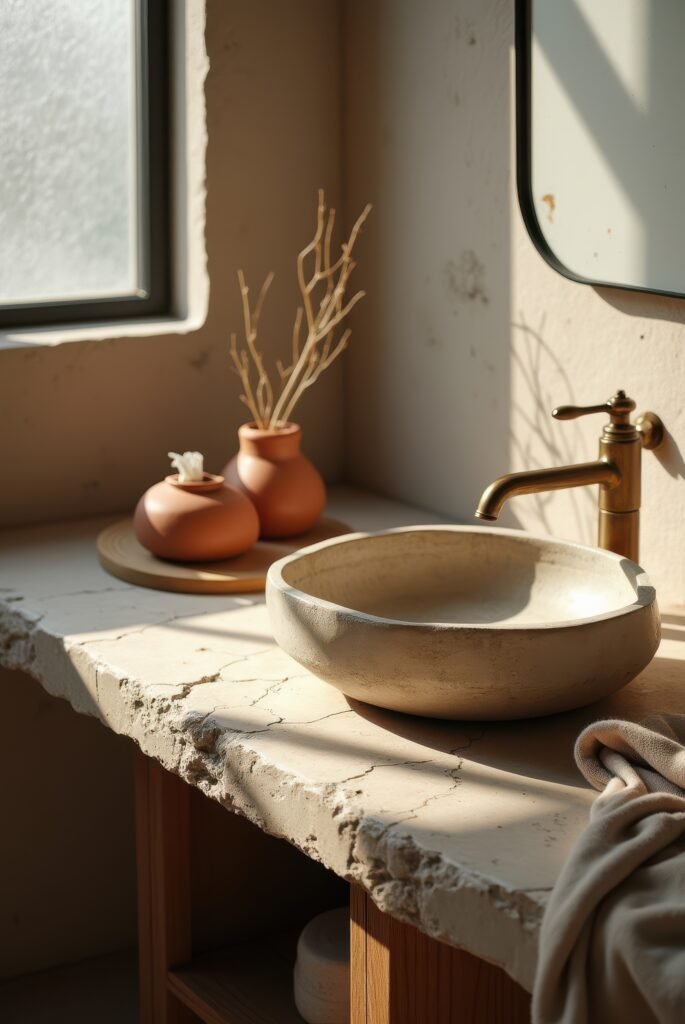
- Imperfection as Authenticity
Forget chasing that showroom-perfect look. Wabi Sabi leans into imperfections. That might mean showing off the wood grain on your vanity or leaving your clay tiles slightly uneven. I once saw a bathroom with a handmade ceramic sink that had little ridges from the potter’s fingers—it was so cool. You could try things like terracotta pots for storage or a stone countertop with its natural fissures still visible. - Transience and Natural Cycles
Wabi Sabi reminds us nothing lasts forever. Wood changes color. Walls get scuffed. And guess what? That’s awesome. You can highlight this by picking materials that develop a patina over time, like unsealed wood or limewash walls that crackle a bit in humidity. Or maybe swap out décor every season with dried flowers or branches so your bathroom evolves naturally with the year. - Simplicity Through Intentionality
Don’t confuse simplicity with looking empty or boring. Every item in a Wabi Sabi Bathroom serves a purpose, but there aren’t too many items to begin with. For instance, you might have a single linen shower curtain that calms the space, or a hand-carved soap dish that feels special. This pared-down approach helps you be more mindful—turning your morning shower into a mini retreat.
Contrasting Wabi Sabi With Western Design Ideals
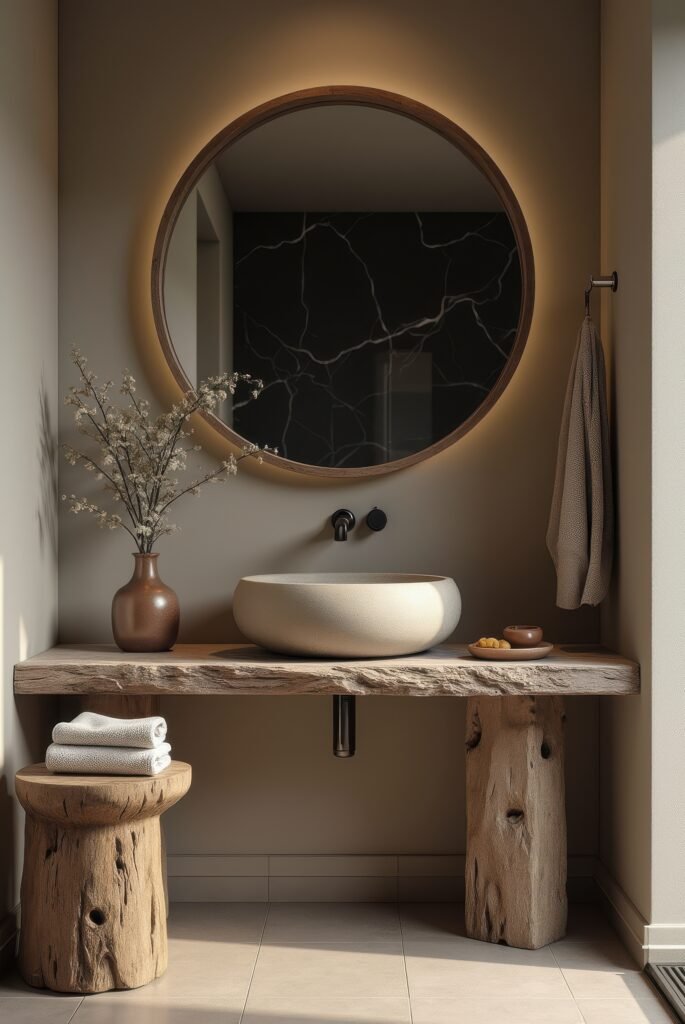
Most modern Western bathrooms focus on glossy tiles, hidden plumbing, and slick fixtures. Wabi Sabi is the opposite. Imagine showing off exposed copper pipes that develop a greenish patina instead of hiding them. Or using a hammered brass basin that’s not perfectly shaped. Wabi Sabi also doesn’t chase trends. While Instagram might show bright accents or high-tech gadgets, a Wabi Sabi Bathroom sticks with earthy colors and timeless elements that grow on you year after year.
Mindfulness in Practice
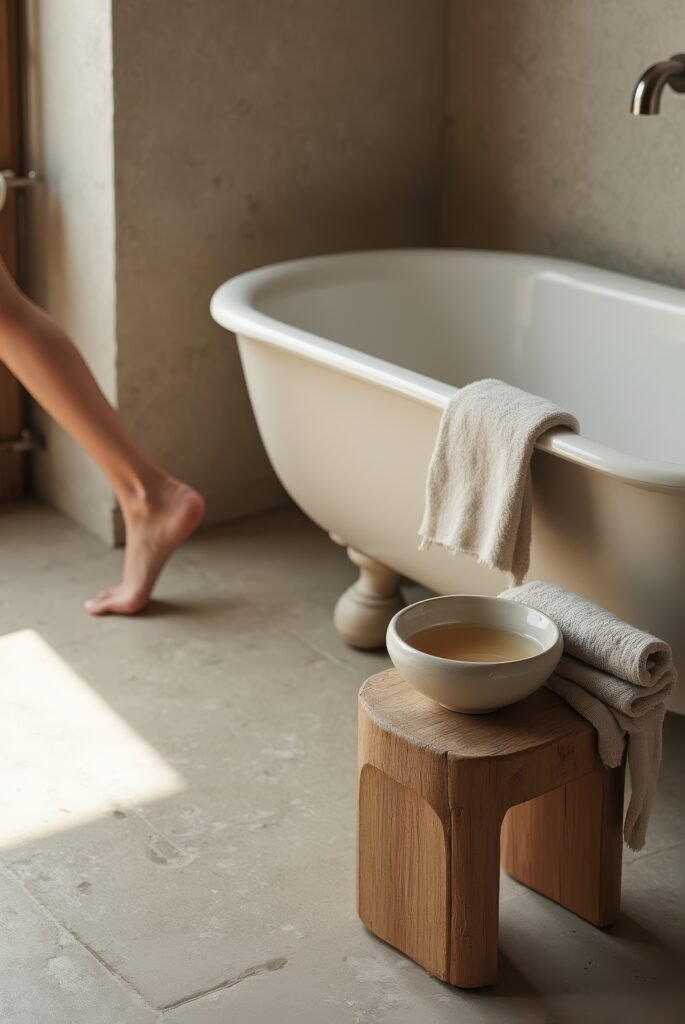
What’s really neat is how Wabi Sabi design encourages mindfulness. Natural materials—like stone floors or wooden stools—feel great to the touch. Even caring for these pieces can be a calming ritual. Oiling that teak stool or cleaning a stone sink can become a moment of Zen instead of just another chore.
Translating Wabi Sabi Principles to Bathroom Design
Now, how do you actually create a Wabi Sabi Bathroom? It’s all about choosing the right materials, colors, and embracing those “flaws” as features. Below are some ways to bring these ideas into the real world, including stuff folks have tried and loved.
Embracing Natural Materials
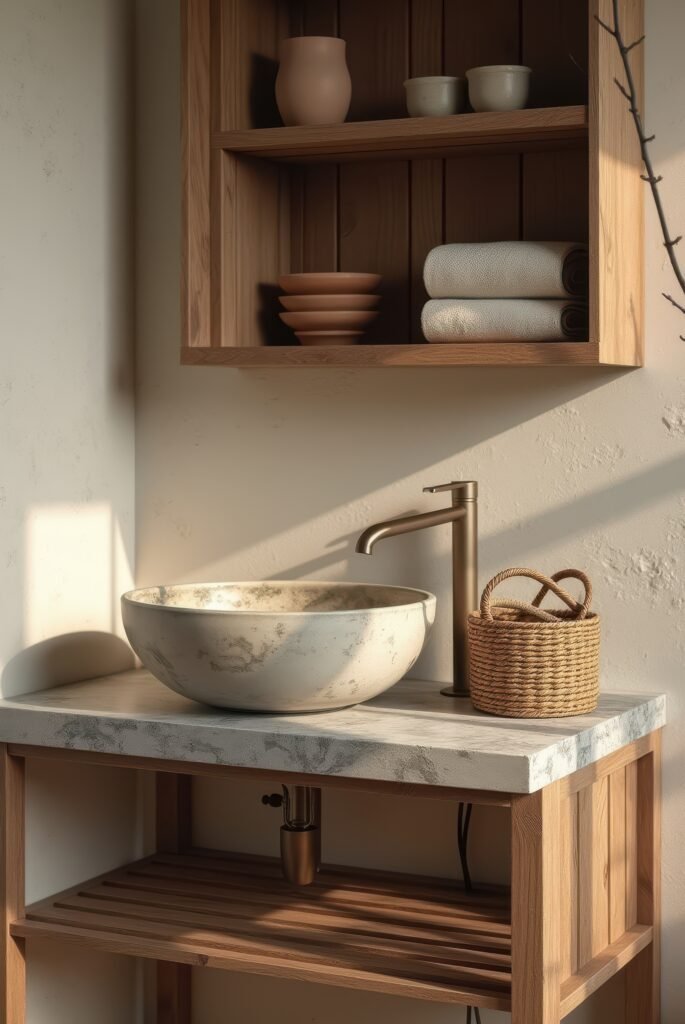
At the heart of Wabi Sabi is a love for things like wood, stone, clay, and linen. These materials aren’t just for show—they connect you to nature’s rhythms. For example, a teak vanity that gradually turns silvery or terracotta tiles that wear down over time can look amazing. Handmade ceramics are also great. I bought an imperfectly glazed soap dish at a craft fair, and it’s my favorite thing.
Textured walls are another way to go. Techniques like limewash or tadelakt plaster give walls a slightly rough and varied finish that invites touch. Modern tweaks like concrete basins can also work if they keep that rugged, stone-like vibe. If you’re renting, try removable bamboo shelves or woven baskets—easy to swap out when you move.
Neutral Color Palettes for Serenity
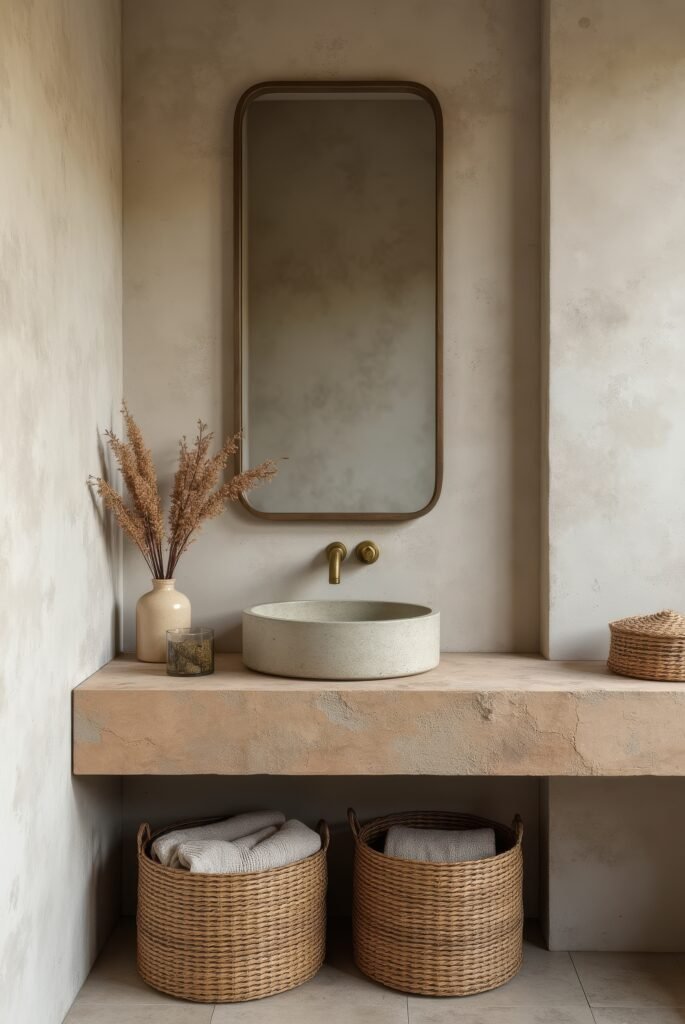
Color in a Wabi Sabi Bathroom is like a soft background singer. It doesn’t steal the show; it just sets the mood. Think muted greys, warm beiges, and chalky whites. To keep it from feeling too flat, you can add small contrasts—like matte black faucets or copper fixtures that’ll age into greenish tones.
Real-life tip: I saw a Reddit thread where someone was repainting a bathroom with old floral tiles. They ended up choosing a deep teal, and it worked wonders. It balanced the vintage tile without clashing. Another good trick is using soft sage greens or terracotta-like hues for a calm, earthy vibe. In small bathrooms, go lighter on big surfaces so everything feels open, then add darker hardware or accessories to keep things interesting.
Celebrating Imperfections
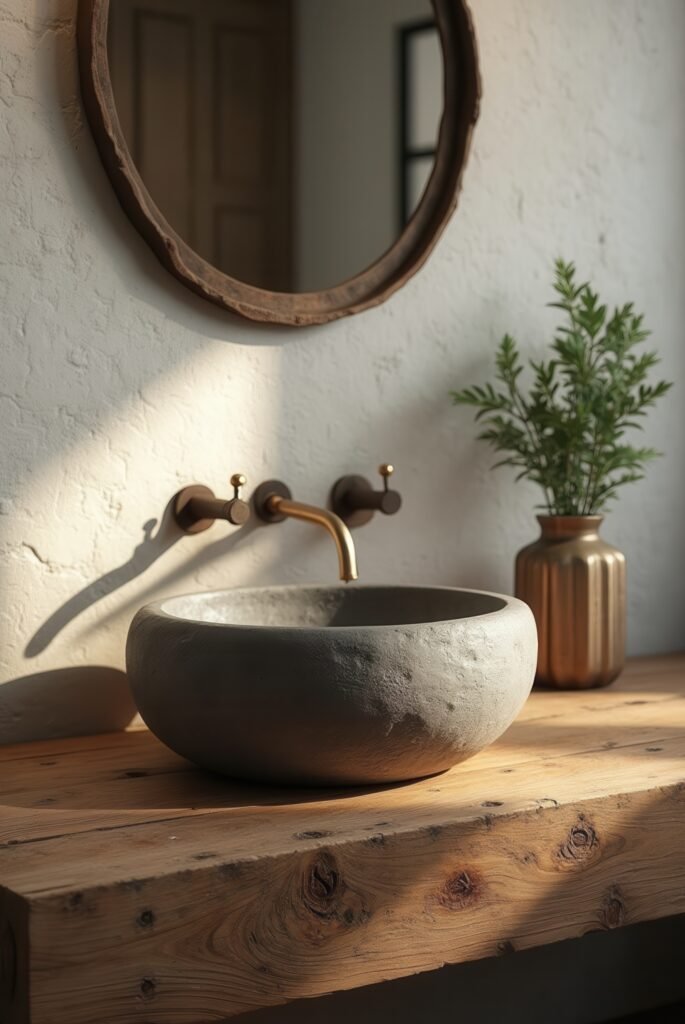
Here’s the heart of Wabi Sabi: embrace the flaws. A chipped tile or a reclaimed wood vanity with knots and scratches can become an awesome focal point. I once saw a volcanic rock sink that kept its tiny holes on the surface, and it was oddly beautiful. Also, instead of hiding plumbing, try exposed copper pipes and let them turn that cool green.
For a more handcrafted feel, you could use zellige tiles. They’re known for their slightly uneven surfaces and random color variation. Even a mismatched thrift-shop mirror can look intentional if you set it up just right. Just be careful not to fake it—stuff that’s artificially distressed can feel a bit staged. Pick materials that naturally show their age, like wood that darkens over time or linen that softens with every wash.
Creating a Wabi Sabi Bathroom in Small Spaces
If you live in a cozy apartment like I do, you might be thinking, “My bathroom’s the size of a closet. Can I still do Wabi Sabi?” Totally. You just need to be a little smarter with your layout and choices. It’s all about being resourceful.
Space-Saving Layouts
You don’t have a lot of room, so make every inch count. Floating vanities open up the floor, and open shelves made of reclaimed wood or bamboo can hold towels or handmade ceramics. Built-in niches for toiletries look great, especially if you keep the edges a bit raw.
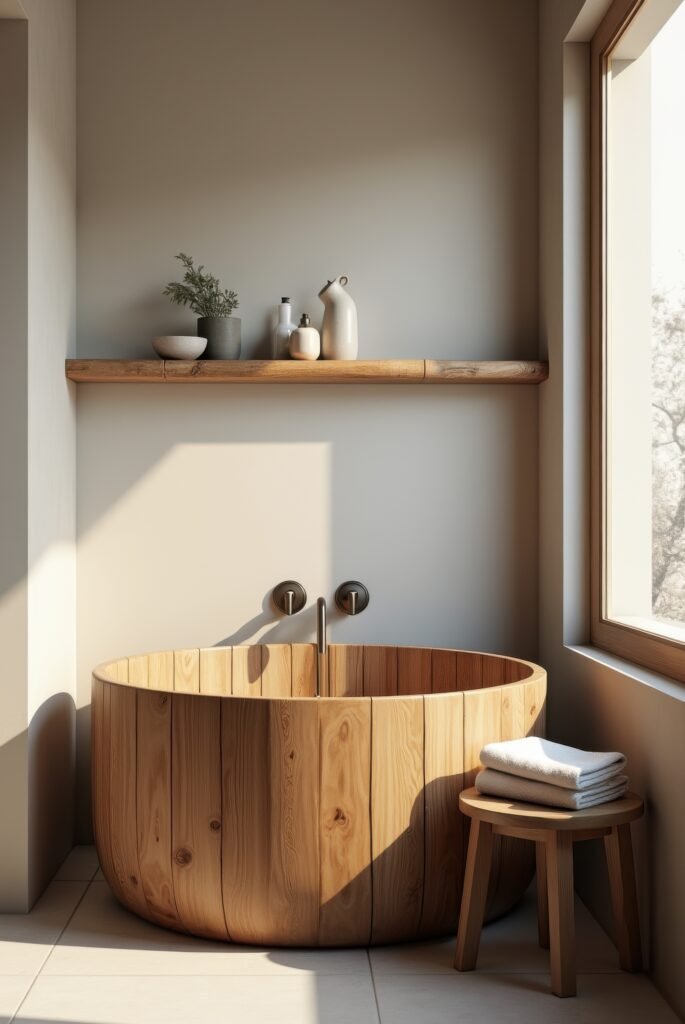
Japanese ofuro tubs are a small-bathroom win. They’re compact but let you soak deeply. Pair them with wall-mounted faucets for a clean look. Or consider a “wet room,” where the shower and the rest of the bathroom share a continuous floor, often with a single glass partition. For flexible setups, tension rods or folding screens can divide space without permanent construction.
Budget-Friendly Adaptations
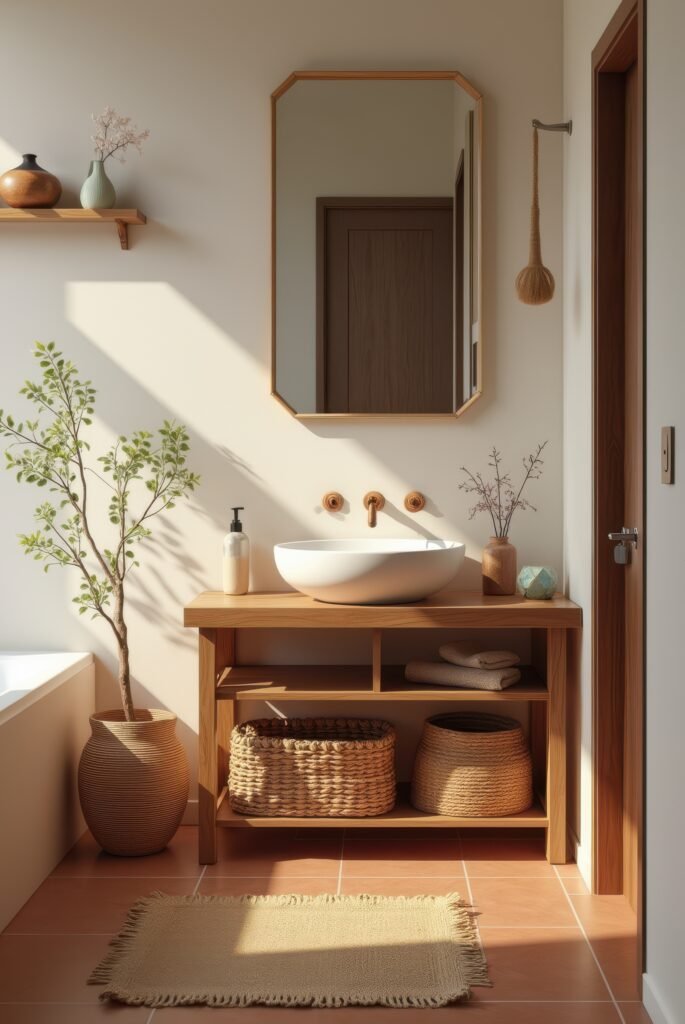
You don’t need to blow your savings. Sand down an old vanity to reveal the raw wood grain, or paint existing tiles with a limewash effect for that aged look. Thrift stores are goldmines for slightly chipped pottery or mirrors with cool, weathered frames. One Reddit user redid their bathroom with just a few bucks for bamboo shelves and DIY clay planters.
Peel-and-stick tiles that mimic terracotta or stone are perfect if you rent. Layer jute rugs on the floor for warmth and texture. Even IKEA basics can be Wabi Sabi if you pair them with handmade hardware. The key is leaving a bit of negative space so your bathroom doesn’t feel stuffed.
Lighting for Tranquility
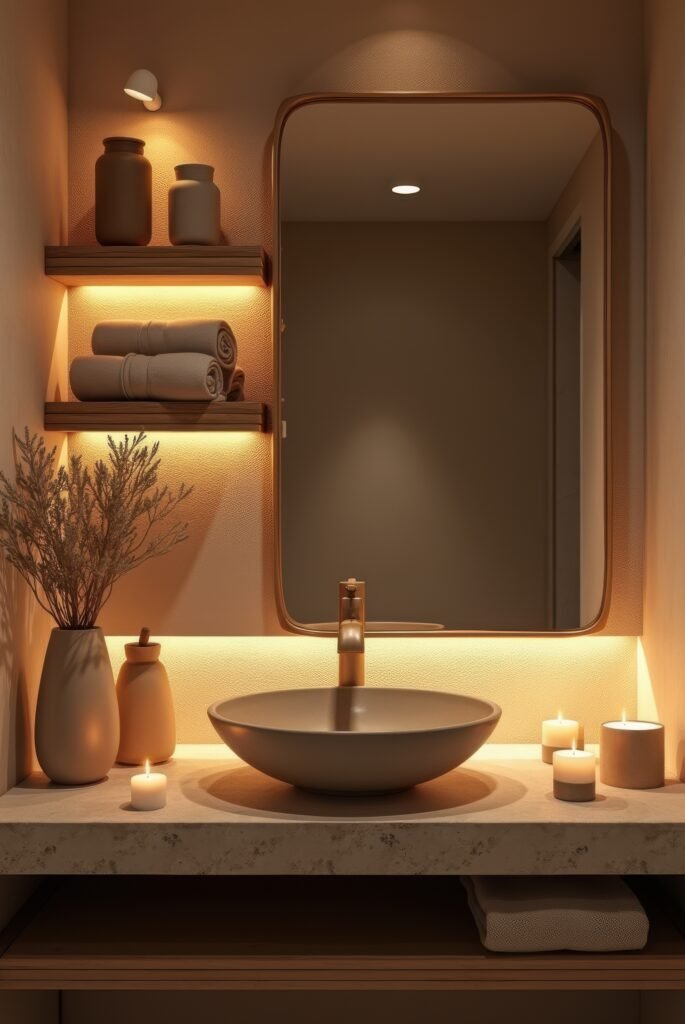
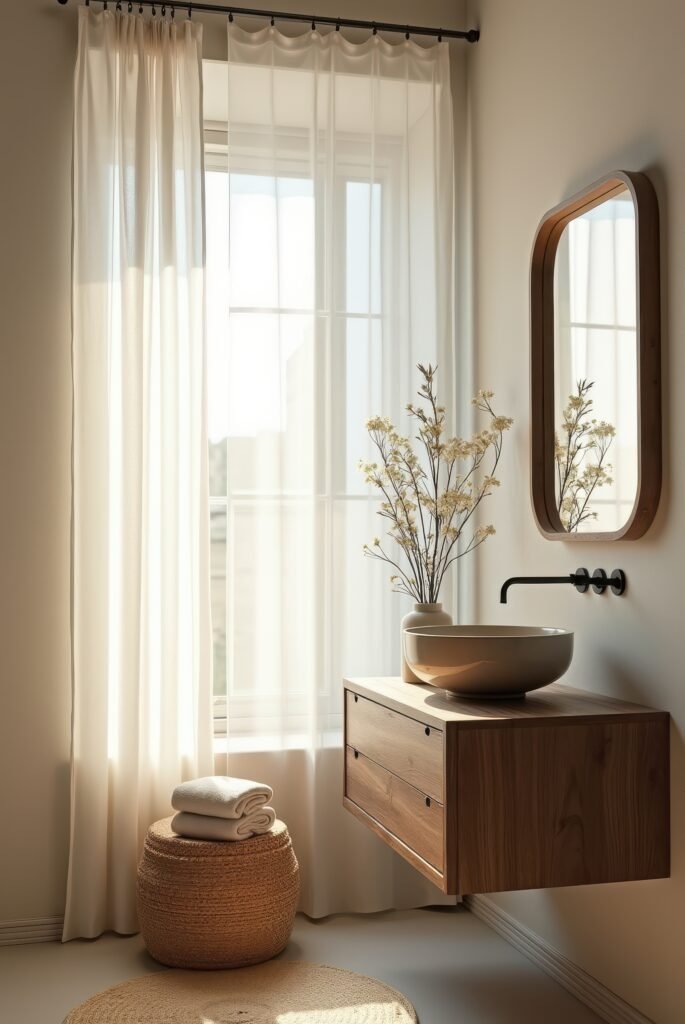
Lighting can totally change the vibe. Harsh overhead lights? No thanks. Go for paper lanterns or frosted sconces to create a soft glow that shows off your textured walls. If your bathroom doesn’t have windows, try LED strips behind shelves for a subtle, natural effect.
If you do have a window, hang sheer linen curtains. They’ll let in light but still keep privacy. And for cozy evening baths, add candles in uneven ceramic holders. In one Home Decorating thread, people got a spa-like glow by switching from bright white bulbs to warmer 2700K LEDs.
Balancing Minimalism and Warmth
Wabi Sabi can feel minimal, but it’s never cold. It’s all about mixing a few well-chosen items with natural textures and shapes. A small apartment bathroom might look extra sleek with minimal clutter, but you don’t want it to feel like a hospital, right?
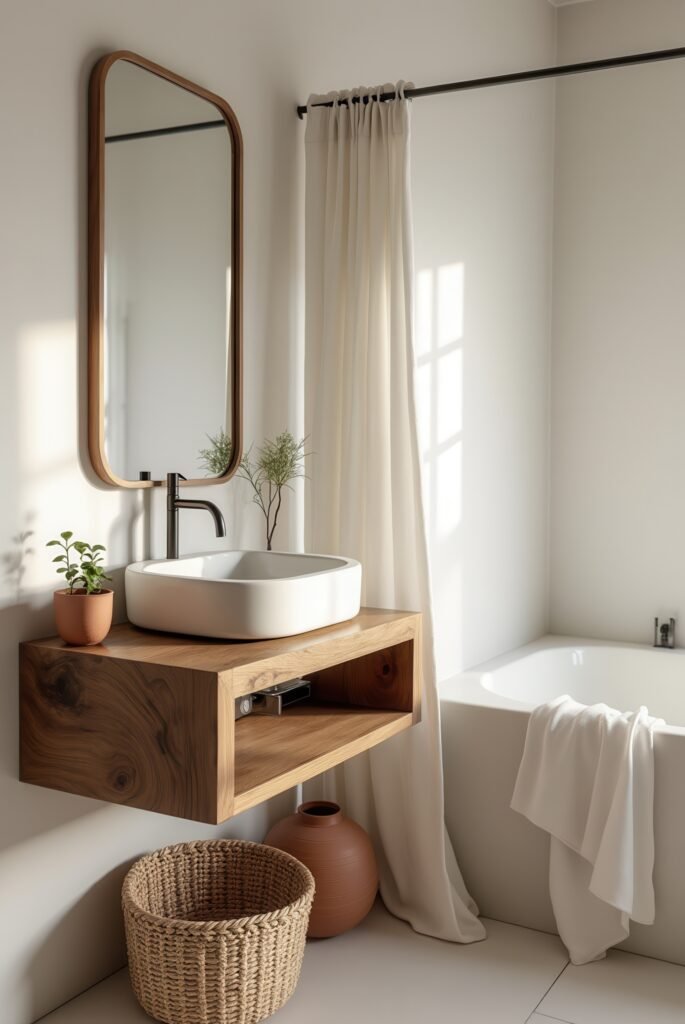
- Organic Textures
Pair a floating vanity with a woven seagrass basket for laundry. Add a plant in a handmade clay pot. Swap a plastic shower curtain for linen or hemp. These small touches bring life and warmth to a space that could otherwise feel bare. - Layering Materials
Mix smooth surfaces with rougher ones. Maybe a plaster wall next to a teak tub. Or a brushed concrete floor paired with glossy ceramic canisters. A single accent wall—say, travertine stone—can really pop without overwhelming a small bathroom. - Tactile Fixtures
Think matte black faucets or unlacquered brass that changes color over time. Curved edges on tubs or sinks. Even the lighting can add texture. Paper lanterns throw a gentle glow that highlights any little wall imperfections.
Challenges and Practical Considerations
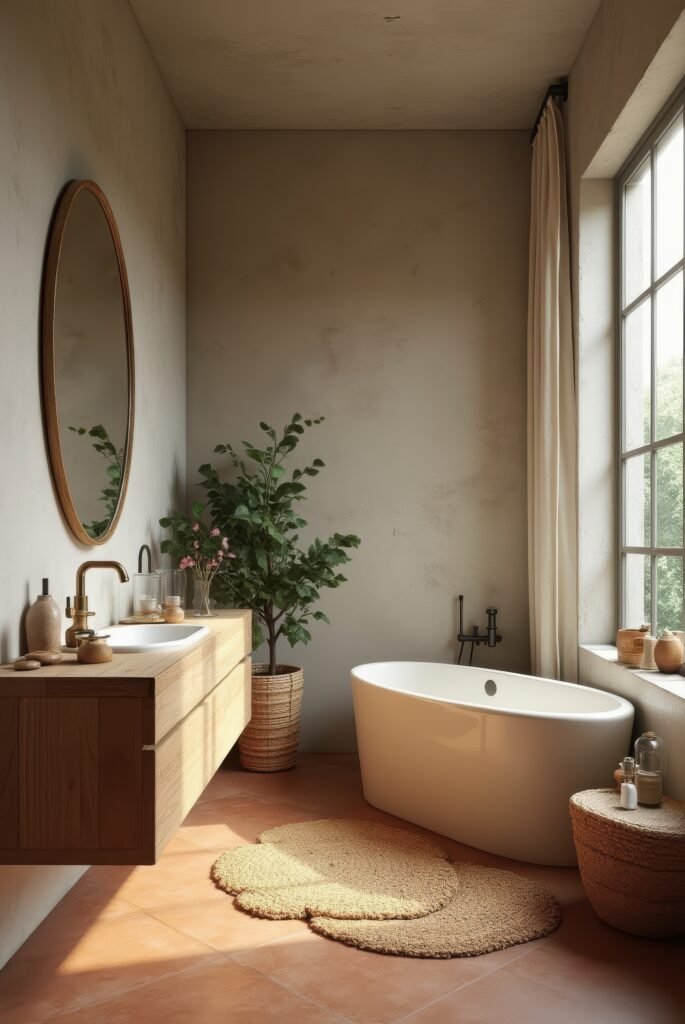
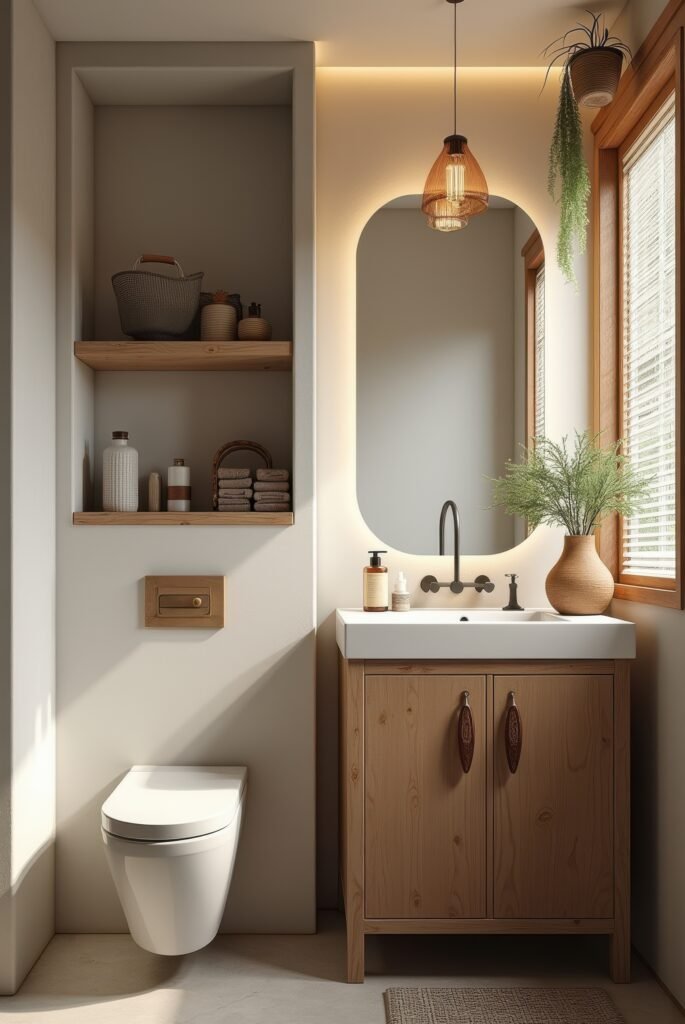
Wabi Sabi sounds lovely, but let’s keep it real: bathrooms can be tricky because of moisture, limited space, and the need for daily functionality. Here’s how to handle common issues:
- Material Upkeep
Wood vanities need oils or sealants to handle moisture. Terracotta tiles should be sealed regularly. Renters can try removable bamboo mats or peel-and-stick faux-stone floors. And mold is a big no-no—address it quickly with mold-resistant paints or coatings. - Avoid “Rustic Overload”
Too many raw textures in a tiny space might look messy. Focus on one main feature—like a plaster shower wall—and let the rest be calm and simple. Also, forced distressing (like factory-made “rustic” finishes) can feel fake. - Budget Constraints
Yes, artisan pieces can be pricey. But DIY and thrifting save the day. People have done entire bathroom makeovers with $5 shelves and clay planters. IKEA cabinets plus unique drawer pulls can also strike a nice balance. - Spatial Limitations
Floating vanities and recessed niches open up room, but can appear sterile if you’re not careful. Soften them with jute rugs or a hanging plant. For better lighting, ditch overhead fluorescents in favor of warm LEDs or frosted sconces . - Functionality vs. Aesthetics
Vessel sinks look cool, but they sometimes splash water everywhere. Same with open shelving—it can become cluttered fast. Workarounds include wall-mounted faucets, partial cabinets with woven fronts, or “bathroom bags” for each family member to keep stuff neat. - Embracing Evolution
A Wabi Sabi Bathroom is never “done.” Let it grow and change. Maybe your wood shelf darkens from steam or your copper fixture gains a patina. Swap out dried bouquets seasonally. It’s all part of the charm.
Psychological and Sustainable Benefits of Wabi Sabi Bathrooms
There’s more to a Wabi Sabi Bathroom than good looks. It can actually boost your mood and help the planet:
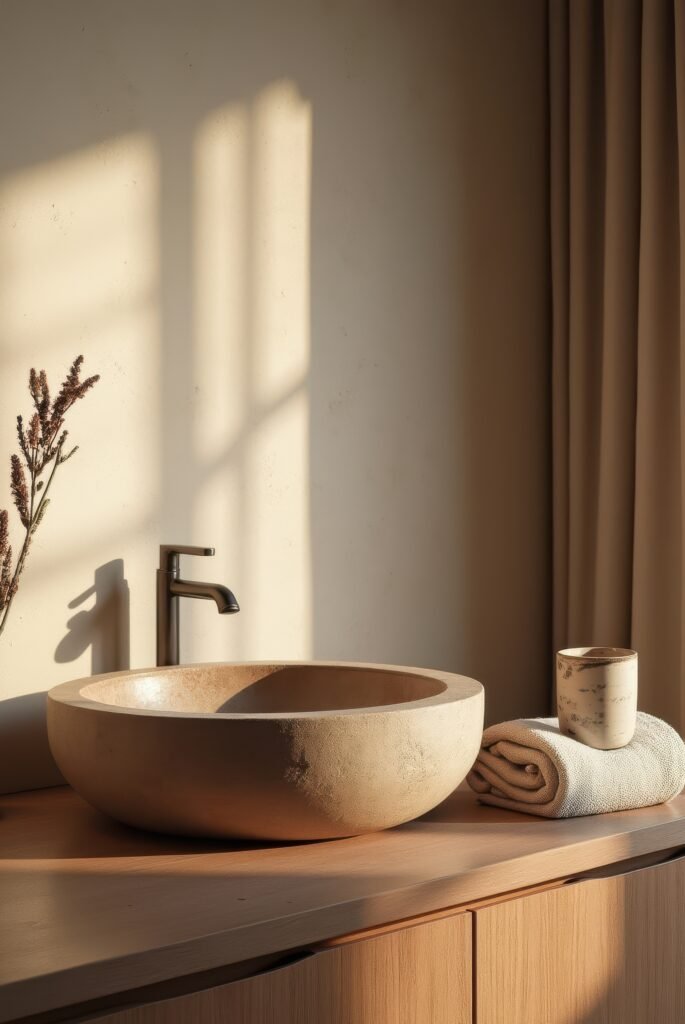
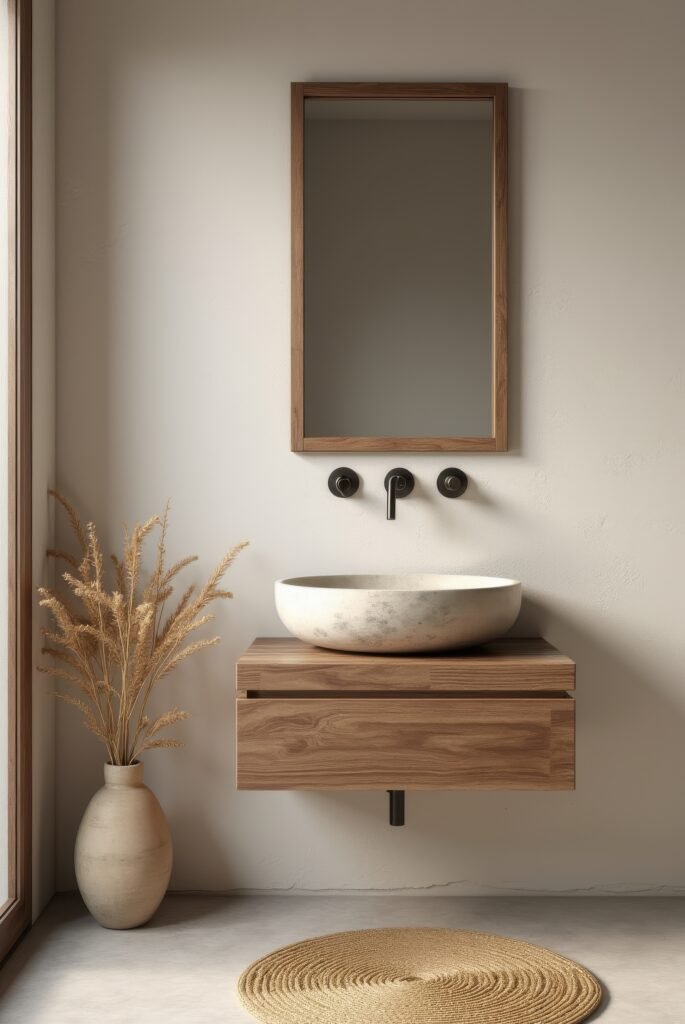
- Mindfulness
Natural textures and calming colors pull you into the present moment. Little details—like feeling the rough edge of a stone sink—become daily rituals. Studies show earthy tones can reduce stress hormones, so even brushing your teeth might feel more peaceful. - Sustainability
Wabi Sabi leans into using reclaimed, long-lasting materials. Instead of ripping out dated tiles, you might preserve and celebrate them. Things like unlacquered brass and terracotta just get better with age, meaning less waste. A Brooklyn renovation found reclaimed wood and tiles cut emissions by 40% (compared to brand-new stuff). - Reduced Environmental Impact
Bamboo shelves, cork floors, and clay pots usually take less energy to produce than plastic or metal. Plus, focusing on timeless, evolving design means you won’t be updating your bathroom every few years (saving money and resources). - Emotional Resilience
Embracing imperfections in your surroundings can help you accept them in yourself, too. Sounds a bit deep, but it’s true. Letting go of the idea that everything has to be perfect can reduce anxiety and make your home a place of calm.
Blending Wabi Sabi with Modern Trends
Wabi Sabi doesn’t have to be stuck in tradition. It can mesh with other styles like Japandi, biophilic design, or even industrial minimalism.
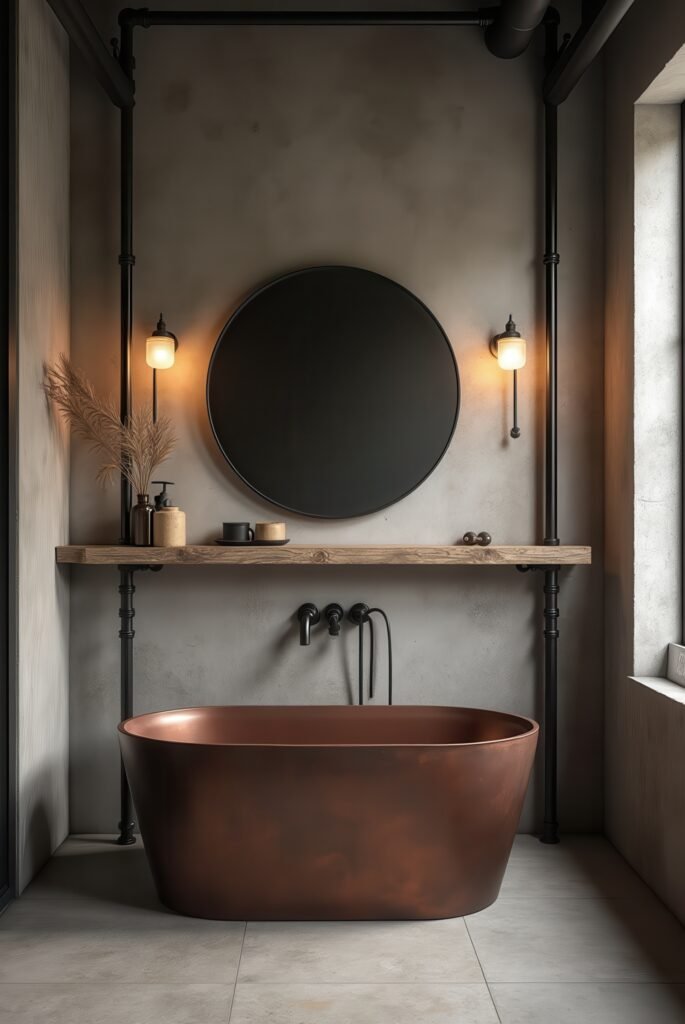
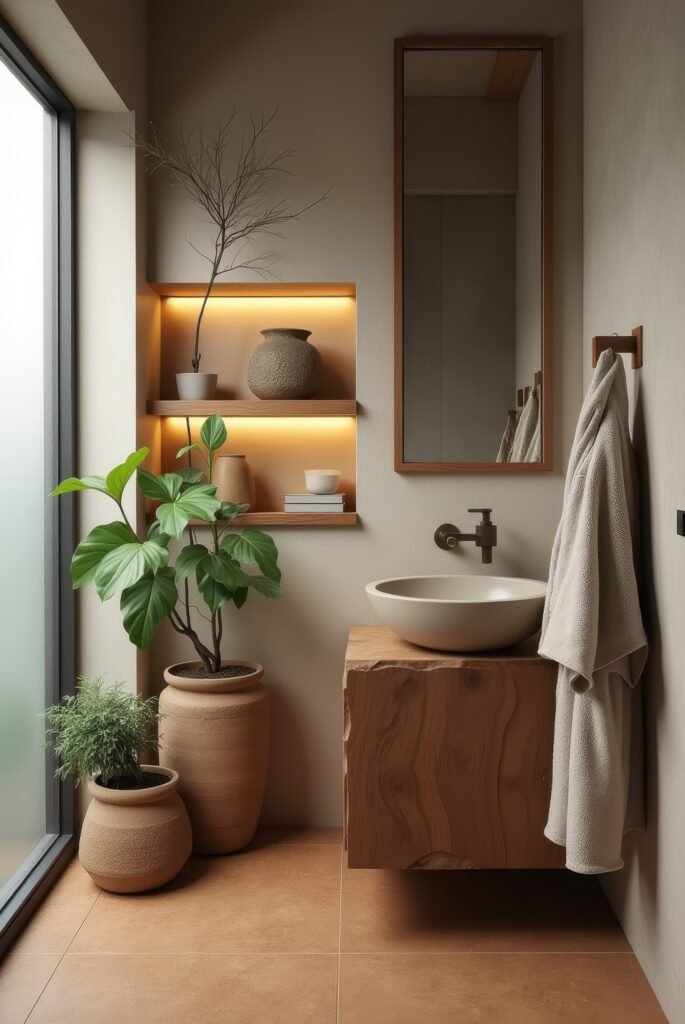
- Japandi Fusion
This combines Japanese and Scandinavian elements. Picture a floating vanity in light ash wood and crisp white walls, accented by a hand-carved teak stool. It’s clean and modern, but still warm and authentic. - Biophilic Design
Biophilic design is about bringing nature indoors. So, load up on potted plants in clay pots or hang dried branches in your shower space. If you’re short on natural light, use LED strips or wallpaper that mimics greenery. - Industrial Accents
Exposed pipes and concrete floors can vibe with Wabi Sabi if you soften them. Maybe a copper tub that patinas over time, or some reclaimed barn wood shelves. Unlacquered brass faucets also help merge that industrial edge with organic imperfection.
Tips for Apartment Dwellers:
- Hybrid fixtures like wall-mounted faucets in matte finishes
- Removable peel-and-stick wallpapers or tiles
- Vintage or thrifted mirrors and basins
- Soft, layered lighting
Just keep it cohesive. Don’t overwhelm a space with too many different styles at once. And remember, using reclaimed or local materials can be more eco-friendly, too.
Common Pitfalls to Avoid
Even the chillest aesthetic has potential pitfalls. Here’s what can go wrong and how to steer clear:
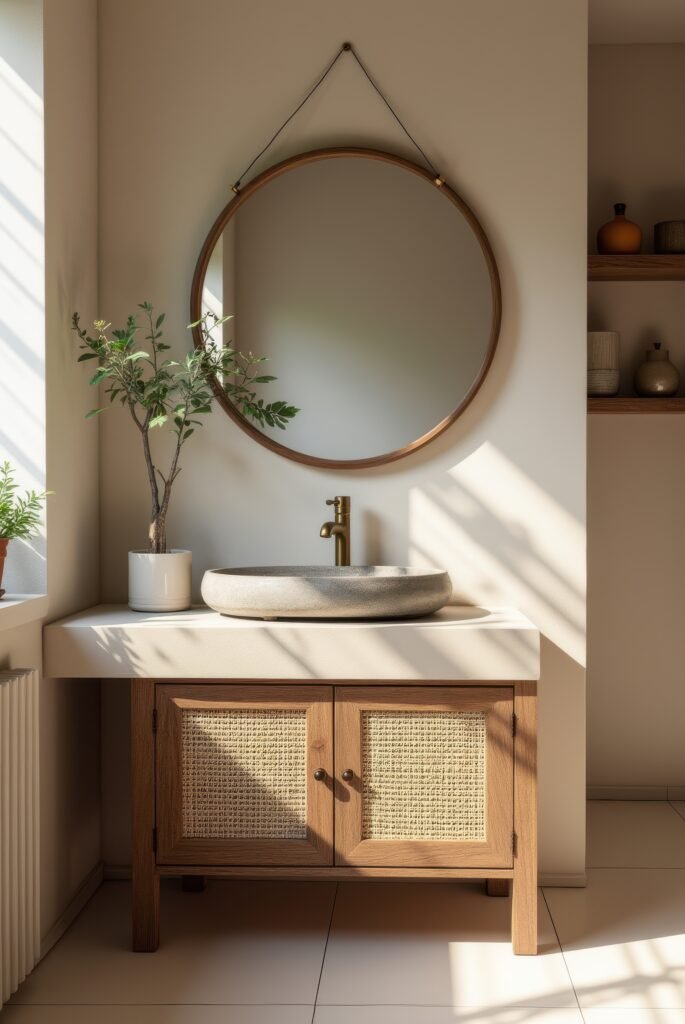
- Overdoing Rustic Elements
Too many raw, rough surfaces can feel cluttered. Highlight one or two, like a reclaimed wood shelf or tadelakt shower, and keep the rest simple. - Ignoring Function
Vessel sinks can splash, open shelves can look messy. Consider practical solutions like under-mount sinks or partial cabinets with hidden storage. - Faking Imperfections
Avoid artificially distressed items that look staged. Let metals patina or wood wear naturally. - Forgetting Humidity
Wood and limewash walls need protection in damp spaces. Seal terracotta tiles and use moisture-resistant wood like teak or bamboo. - Clashing Colors
Stick to a few earthy tones and add depth with subtle accents. Too many colors can ruin the calm vibe. - Harsh Lighting
Swap bright fluorescents for frosted sconces, warm LEDs, or even candles in handmade holders.
Conclusion
So that’s the heart of a Wabi Sabi Bathroom: it’s about celebrating imperfections, choosing materials that evolve over time, and creating a mindful space that helps you slow down. If I had to pick just three big takeaways, I’d say:
- Don’t fight flaws—let them tell a story.
- Keep it simple—the right amount of stuff makes all the difference.
- Use nature’s gifts—raw wood, stone, and soft linens bring a comforting vibe.
What now? Maybe it’s time to explore some thrift stores or try a DIY project (like sanding down that old vanity) so you can add a personal, lived-in touch. You could also check out some local ceramic artists—they might have just the imperfectly perfect soap dish or planter you need. And hey, if you give any of these tips a shot, let me know how it goes. I’d love to hear about your favorite “happy accidents” and how they added character to your space. I’m a total sucker for bathroom makeovers that tell a story.
Alright, I think we’re all set. Take your time, enjoy the process, and let your bathroom evolve naturally.
FAQs
Can I achieve a Wabi Sabi Bathroom on a tight budget?
Absolutely. Thrift stores and DIY projects are your best friends. A lot of people have done makeovers for under $300 using secondhand treasures and creative hacks.
How do I prevent mold on natural materials?
Seal anything porous, like terracotta or grout. Keep the space ventilated. Renter-friendly tip: use antimicrobial hemp or linen shower curtains.
Can I mix Wabi Sabi with modern industrial design?
Sure. Think concrete floors paired with a teak bath mat, or exposed copper pipes with a woven wall hanging. It’s all about balancing rough and refined.
Is Wabi Sabi suitable for small, windowless bathrooms?
Definitely. Fake some natural light with sheer curtains over artificial light sources. Throw in reflective surfaces like an unpolished brass mirror to bounce light around.
How do I keep a “lived-in” look without clutter?
Store daily items on a wooden tray or in woven baskets, and stash extras in closed cabinets. Rotate your décor every season, so it feels fresh yet still personal.



